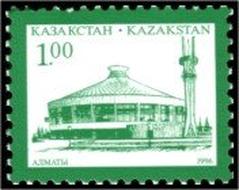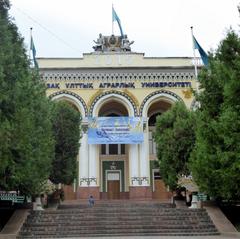Comprehensive Guide to Visiting Ile-Alatau National Park, Almaty, Kazakhstan
Date: 17/07/2024
Introduction
Ile-Alatau National Park, nestled in the Almaty region of Kazakhstan, is a haven for nature enthusiasts and history buffs alike. Established in 1996, this park spans an impressive 200,000 hectares and boasts a rich tapestry of ecosystems, from semi-deserts to alpine meadows. Its establishment marked a significant milestone in Kazakhstan’s broader environmental conservation efforts, particularly those aimed at preserving the unique biodiversity of the Tien Shan mountain range. Visitors to Ile-Alatau National Park can expect to encounter a stunning array of flora and fauna, including the endangered snow leopard and wild apple trees believed to be the ancestors of all modern apple varieties (Complete Guide to Ile-Alatau National Park - Must-See Attractions, Visiting Hours, and Travel Tips). The park’s historical significance is equally compelling, with numerous archaeological sites providing a window into the region’s prehistoric and early historic periods. Whether you’re drawn by the park’s natural beauty, its cultural resonance, or its educational offerings, Ile-Alatau National Park promises a memorable experience for all who visit.
Table of Contents
- [Introduction](#introductionintroduction)
- [History and Significance of Ile-Alatau National Park](#history-and-significance-of-ile-alatau-national-parkhistory-and-significance-of-ile-alatau-national-park)
- [Historical Background](#historical-backgroundhistorical-background)
- [Ecological Significance](#ecological-significanceecological-significance)
- [Cultural and Historical Significance](#cultural-and-historical-significancecultural-and-historical-significance)
- [Visitor Information](#visitor-informationvisitor-information)
- [Practical Information](#practical-informationpractical-information)
- [Travel Tips](#travel-tipstravel-tips)
- [Educational Programs](#educational-programseducational-programs)
- [Conservation Efforts](#conservation-effortsconservation-efforts)
- [Challenges and Future Directions](#challenges-and-future-directionschallenges-and-future-directions)
- [FAQ](#faqfaq)
- [Conclusion](#conclusionconclusion)
History and Significance of Ile-Alatau National Park
Historical Background
Ile-Alatau National Park, established in 1996, is a significant natural reserve located in the Almaty region of Kazakhstan. The park spans an impressive 200,000 hectares, encompassing a diverse range of ecosystems from semi-deserts to alpine meadows. The park’s history is deeply intertwined with the broader environmental conservation efforts in Kazakhstan, which began in earnest during the Soviet era. The establishment of the park was part of a broader initiative to protect the unique biodiversity of the Tien Shan mountain range, recognized for its ecological significance and stunning landscapes.
Ecological Significance
The park is home to over 1,000 species of plants, 39 species of mammals, and 200 species of birds. Among the notable flora are the wild apple trees (Malus sieversii), believed to be the ancestors of all modern apple varieties. The park’s fauna includes the endangered snow leopard (Panthera uncia), the Tien Shan brown bear (Ursus arctos isabellinus), and the Central Asian lynx (Lynx lynx isabellinus). The presence of these species highlights the park’s critical role in biodiversity conservation. The park’s diverse habitats, ranging from lowland steppes to high-altitude glaciers, provide a sanctuary for these species, many of which are threatened by habitat loss and climate change.
Cultural and Historical Significance
Ile-Alatau National Park is not only a natural treasure but also a site of cultural and historical importance. The park contains numerous archaeological sites, including ancient petroglyphs and burial mounds, which provide insights into the region’s prehistoric and early historic periods. These sites are remnants of the various nomadic cultures that have inhabited the region over millennia. The park’s landscapes have also inspired numerous works of art and literature, reflecting its cultural resonance in Kazakh heritage.
Visitor Information
Practical Information
- Visiting Hours: Ile-Alatau National Park is open daily from 9 AM to 6 PM.
- Tickets: Entrance fees are approximately $2 for adults and $1 for children. Special discounts may be available for groups and students.
- Accessibility: The park offers several accessible trails and facilities to accommodate visitors with disabilities.
Travel Tips
- Best Times to Visit: The best times to visit are during spring (April to June) and autumn (September to October) when the weather is mild and the landscapes are particularly beautiful.
- Nearby Attractions: Consider visiting the Medeu Skating Rink, Shymbulak Ski Resort, and Big Almaty Lake, which are all located close to the park.
- Guided Tours: Guided tours are available and highly recommended for a more in-depth understanding of the park’s natural and cultural heritage.
- Photographic Spots: Popular spots for photography include the Alpine meadows, Tien Shan glaciers, and ancient petroglyph sites.
Educational Programs
The park’s visitor centers provide educational programs and exhibits that highlight the park’s natural and cultural heritage. These programs aim to raise awareness about the importance of conservation and promote sustainable tourism practices. The park’s well-maintained trails and facilities ensure that visitors can enjoy its natural beauty while minimizing their impact on the environment.
Conservation Efforts
The establishment of Ile-Alatau National Park was a significant step in Kazakhstan’s efforts to preserve its natural heritage. The park is managed by the Ministry of Ecology, Geology, and Natural Resources of Kazakhstan, which implements various conservation programs aimed at protecting the park’s biodiversity. These programs include anti-poaching patrols, habitat restoration projects, and scientific research initiatives. The park also collaborates with international organizations, such as the World Wildlife Fund (WWF) and the International Union for Conservation of Nature (IUCN), to enhance its conservation efforts.
Challenges and Future Directions
Despite its many successes, Ile-Alatau National Park faces several challenges. Climate change poses a significant threat to the park’s ecosystems, with rising temperatures and changing precipitation patterns affecting the distribution and behavior of species. Human activities, such as illegal logging and mining, also pose risks to the park’s biodiversity. To address these challenges, the park’s management is focusing on enhancing its monitoring and enforcement capabilities, as well as promoting community involvement in conservation efforts. The park is also exploring opportunities for expanding its protected areas and improving its infrastructure to better accommodate visitors.
FAQ
- What are the best times to visit Ile-Alatau National Park? The best times to visit are during spring (April to June) and autumn (September to October) when the weather is mild and the landscapes are particularly beautiful.
- Are there guided tours available in Ile-Alatau National Park? Yes, guided tours are available and highly recommended for a more in-depth understanding of the park’s natural and cultural heritage.
Conclusion
Ile-Alatau National Park is a vital component of Kazakhstan’s natural and cultural heritage. Its rich biodiversity, stunning landscapes, and historical significance make it a unique and valuable destination. Through ongoing conservation efforts and sustainable tourism practices, the park aims to preserve its natural beauty and ecological integrity for future generations. Visitors to the park can experience its diverse ecosystems, learn about its cultural history, and contribute to its conservation by practicing responsible tourism.
Call to Action
Plan your visit to Ile-Alatau National Park today and discover the natural and cultural wonders of Almaty. Download the Audiala mobile app for more travel tips and updates, and follow us on social media for the latest news and events.


















